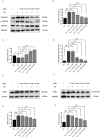Chlorogenic Acid Attenuates Isoproterenol Hydrochloride-Induced Cardiac Hypertrophy in AC16 Cells by Inhibiting the Wnt/β-Catenin Signaling Pathway
- PMID: 38398512
- PMCID: PMC10892528
- DOI: 10.3390/molecules29040760
Chlorogenic Acid Attenuates Isoproterenol Hydrochloride-Induced Cardiac Hypertrophy in AC16 Cells by Inhibiting the Wnt/β-Catenin Signaling Pathway
Abstract
Cardiac hypertrophy (CH) is an important characteristic in heart failure development. Chlorogenic acid (CGA), a crucial bioactive compound from honeysuckle, is reported to protect against CH. However, its underlying mechanism of action remains incompletely elucidated. Therefore, this study aimed to explore the mechanism underlying the protective effect of CGA on CH. This study established a CH model by stimulating AC16 cells with isoproterenol (Iso). The observed significant decrease in cell surface area, evaluated through fluorescence staining, along with the downregulation of CH-related markers, including atrial natriuretic peptide (ANP), brain natriuretic peptide (BNP), and β-myosin heavy chain (β-MHC) at both mRNA and protein levels, provide compelling evidence of the protective effect of CGA against isoproterenol-induced CH. Mechanistically, CGA induced the expression of glycogen synthase kinase 3β (GSK-3β) while concurrently attenuating the expression of the core protein β-catenin in the Wnt/β-catenin signaling pathway. Furthermore, the experiment utilized the Wnt signaling activator IM-12 to observe its ability to modulate the impact of CGA pretreatment on the development of CH. Using the Gene Expression Omnibus (GEO) database combined with online platforms and tools, this study identified Wnt-related genes influenced by CGA in hypertrophic cardiomyopathy (HCM) and further validated the correlation between CGA and the Wnt/β-catenin signaling pathway in CH. This result provides new insights into the molecular mechanisms underlying the protective effect of CGA against CH, indicating CGA as a promising candidate for the prevention and treatment of heart diseases.
Keywords: Wnt/β-catenin; cardiac hypertrophy; chlorogenic acid.
Conflict of interest statement
The authors declare that they have no competing interests.
Figures









References
-
- Catapano A.L., Daccord M., Damato E., Humphries S.E., Neely R.D.G., Nordestgaard B.G., Pistollato M., Steinhagen-Thiessen E. How should public health recommendations address Lp(a) measurement, a causative risk factor for cardiovascular disease (CVD)? Atherosclerosis. 2022;349:136–143. doi: 10.1016/j.atherosclerosis.2022.02.013. - DOI - PubMed
-
- Harikrishnan S., Jeemon P., Mini G.K., Thankappan K.R., Sylaja P.G.B.D. Global, regional, and national age-sex-specific mortality for 282 causes of death in 195 countries and territories, 1980–2017: A systematic analysis for the Global Burden of Disease Study 2017. Lancet. 2018;392:1736–1788. doi: 10.1016/s0140-6736(18)32203-7. - DOI - PMC - PubMed
MeSH terms
Substances
Grants and funding
LinkOut - more resources
Full Text Sources
Research Materials

